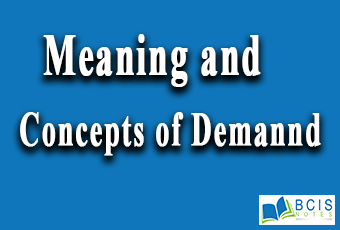
Meaning and Concept of Demand
Demand in economics is defined as consumers’ willingness and ability to consume a given good. An increase in price will decrease the quantity demanded of most goods. A decrease in price will increase the quantity demanded of most goods. The inverse relationship between price and quantity demanded of a good is known as the law of demand. The inverse relationship between price and quantity demanded of a good is known as the demand curve.
The demand curve shows the quantity demanded of a given product at varying price points, holding all else constant. For most goods, this is a downward sloping line.
Demand function
• The functional relationship between the quantity demanded and the determinants of demand.
• Qd (Demand function) = f(Px, Py, ………Py-1,l, E)
Determinants of Individual demand (Factor Affecting the Demand)
• Price of a commodity
Other things being equal, the demand for a commodity is inversely related to its price. It implies that a fall in the price of a commodity leads to an increase in the purchasing power of the consumer and an increase in the demand for the commodity and vise-Versa.
• Price of Related Goods
a. Complementary goods: Complementary goods are those goods which are consumed together to satisfy a particular want. They are jointly demanded. For example, a pen and ink tea and sugar are used together.
b. Substitutes goods: Substitutes goods those goods which can be used once in the place of others. For example, Coke and Pepsi, Tea and Coffee are substitutes for each other and can be used one in place of the other easily.
• The income of the Consumer
The income of the consumer is the basic determinant of the quantity demanded of a commodity as it determines the purchasing power of consumers.
a. Normal goods: There is a direct and positive relationship between the income of the consumer and the demand for normal goods.
b. Inferior goods: There is an inverse relationship between income of consumers and demand for inferior goods, other things being equal. When income rises, demand for inferior goods falls and vise-Versa.
• Tastes and preferences
When the public’s desires, emotions, or preferences change in favor of a product, so does the quantity demanded. Likewise, when tastes go against it that depresses the amount demanded. Brand advertising tries to increase the desire for consumer goods. For example, Buick spent millions to make you think its cars are not only for older people.
• Expectations of future prices and income
When people expect that the value of something will rise, they demand more of it. That explains the housing asset bubble of 2005. Housing prices rose, but people bought more because they expected the price to continue to go up. Prices increased even more until the bubble burst in 2006. Between 2007 and 2011, housing prices fell 30 percent. But the quantity demanded didn’t grow. Why? People expected prices to continue falling. Record levels of foreclosures entered the market due to the subprime mortgage crisis. Demand didn’t increase until people expected future prices would, too. Here is a Jan. 2019 update from Money Tips about 2019 housing market predictions.
• Number of Consumers
The number of consumers affect overall, or “aggregate,” demand. As more buyers enter the market, demand rises. That’s true even if prices don’t change. That was another reason for the housing bubble. Low-cost and sub-prime mortgages increased the number of people who could afford a house. The total number of buyers in the market expanded. This increased demand for housing. When housing prices started to fall, many realized they couldn’t afford their mortgages. At that point, they foreclosed.
• Tax rate: If the government imposed heavy taxes on commodities, it leads to an increase in the price of the commodities and demand will fall. The opposite condition leads to increasing in demand.
• Money supply: If money supply increased in a country, demand is high and vise-Versa.
You may also like this: Meaning and Concepts of Supply

Leave a Reply